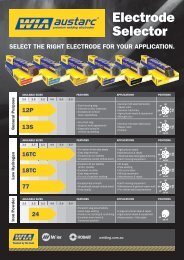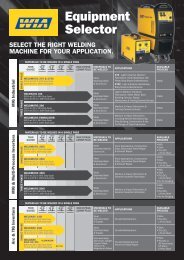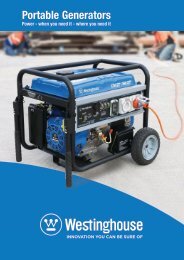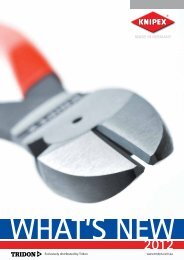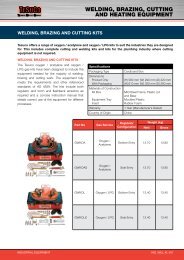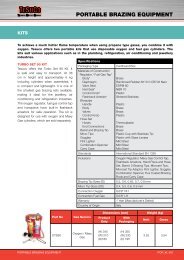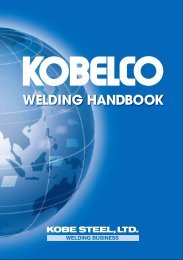Create successful ePaper yourself
Turn your PDF publications into a flip-book with our unique Google optimized e-Paper software.
DRY VACUUM CLEANERS<br />
DRY VACUUM CLEANERS<br />
Dry vacuum cleaners: independent and quiet.<br />
The European energy label for vacuum cleaners.<br />
In many industries, it is the smart, clever solutions that count. For example, significantly quieter operation, easy and quick power cord<br />
change and complete accessory integration. These are the features that allow Kärcher dry vacuum cleaners to impress professional<br />
users such as contract cleaners or cleaning personnel in hotels or retail.<br />
What Kärcher proved long ago with the eco!efficiency vacuum cleaners is now European law: successful cleaning with less power.<br />
Valid from 1 September 2014, the EU energy label for vacuum cleaners limits the nominal power of mains-connected dry vacuum<br />
cleaners to a maximum of 1600 watts. Every machine for sale in Europe must now be marked with the EU energy label. Power and<br />
efficiency combine for the standard and eco!efficiency dry vacuum cleaner ranges from Kärcher – they leave nothing to be desired.<br />
Efficiency at a glance.<br />
Order No.<br />
Tank content (l)<br />
Air quantity (l/s)<br />
Vacuum (mbar / kPa)<br />
Protection class<br />
Antistatic bend<br />
Energy efficiency class*<br />
Annual energy consumption* kWh/year<br />
Carpet cleaning class<br />
Hard floor cleaning class<br />
Dust re-emission class<br />
Sound power level dB(A)<br />
Nominal power consumption W<br />
Page<br />
The energy efficiency class is a Europe-wide uniform classification<br />
and is instantly recognisable. The classification from<br />
A to G which came into force on 1 September 2014 allows a direct comparison.<br />
The basis for the classification into an energy efficiency class is<br />
the annual energy consumption (AE), the value of which is calculated from<br />
a series of different parameters. The most decisive factor is the power<br />
rating of the vacuum cleaner, but the cleaning effect also affects the assessment.<br />
In addition, all eco!efficiency dry vacuum cleaners from Kärcher offer<br />
a cleaning performance that is comparable to their corresponding Standard<br />
version.<br />
Dry vacuum cleaners<br />
T 17/1 eco!efficiency 1.355-141.0 17 43 230 / 23 II A 24.4 D D E 71 750 276<br />
A reference value for comparison.<br />
The annual energy consumption (AE) relates to a defined<br />
T 12/1 eco!efficiency 1.335-136.0 12 43 230 / 23 II A 24.4 D D E 71 750 276<br />
T 10/1 eco!efficiency 1.527-414.0 10 55 210 / 21 II B 28.1 F C E 67 750 276<br />
T 10/1 Adv 1.527-411.0 10 61 244 / 24.4 II E 48.6 E C C 75 1100 278<br />
number of cleaning processes (50 per year) on a standard<br />
living space (87 m²) and is given as a reference value on the energy label.<br />
This value must be at least < 62 kWh/a (Class G) and is given special em -<br />
phasis on the energy label. However, the actual annual energy consumption<br />
BV 5/1 1.394-213.0 5 61 244 / 24.4 II E 47.8 D D B 78 1150 280<br />
depends on the user behaviour, and in particular on the level of soiling, the<br />
Cordless vacuum cleaners<br />
cleaning surface and frequency of cleaning.<br />
T 9/1 Bp 1.528-110.0 9 61 244 / 24.4 / 123 / 12.3 II E 46.5 E C D 81 1150 279<br />
VACUUM CLEANERS<br />
BV 5/1 Bp 1.394-218.0 5 61 244 / 24.4 / 123 / 12.3 II – E 47.8 D D B 78 1150 280<br />
EB machines<br />
EB 30/1 Li-Ion 1.545-128.0 1 – – III – – – – – – – – 281<br />
Brush vacuum cleaners for carpets<br />
CV 60/2 RS Bp 1.011-028.0 17 34 117 / 11.7 II – – – – – – – – 282<br />
CV 66/2 1.012-586.0 35 2 × 52 143 / 14.3 II – – – – – – – – 284<br />
CV 48/2 Adv 1.057-322.0 5.5 48 250 / 25 II – B 31.5 D E 80 1050 286<br />
CV 38/2 Adv 1.033-331.0 5.5 48 250 / 25 II – C 37.4 D E 80 1050 286<br />
CV 30/1 1.023-111.0 5.5 48 207 / 20.7 II – D 42.4 D F 80 1000 288<br />
Included in delivery.<br />
Included nozzle not suitable for use on carpets.<br />
Included nozzle not suitable for use on hard floors.<br />
* Indicative annual energy consumption (kWh per year), based on 50 cleaning processes.<br />
The actual annual energy consumption depends on how the machine is used.<br />
Power instead of noise volume.<br />
It is not only saving energy that equates to practical environmental<br />
protection – but also a reduction in the noise level.<br />
A difference in the noise level of ± 10 dB(A) corresponds to a perceived<br />
halving of the volume. Correspondingly, a vacuum cleaner with a sound<br />
pressure level of 71 dB(A) is perceived as being only half as loud as a<br />
vacuum cleaner with a sound pressure level of 81 dB(A). By listing the<br />
sound pressure level, the energy label provides an additional objective aid<br />
to decision-making.<br />
Vacuuming and containing dust.<br />
An important factor when vacuuming dust is keeping it from<br />
escaping. When it comes to vacuum cleaners, in addition to<br />
the cleaning performance, the dust re-emission is also important and this is<br />
indicated on the energy label with a classification from A to G. The values<br />
VACUUM CLEANERS<br />
for dust re-emission are determined by the manufacturer using a standardised<br />
measurement method in accordance with the EU regulation.<br />
A clean division between hard and soft.<br />
The cleaning differences between hard floors and carpeted<br />
floors are stark and not directly comparable. Therefore the<br />
cleaning classes for hard floors and carpeted floors are indicated separately.<br />
In addition to the energy efficiency class for universal vacuum cleaners, the<br />
hard floor cleaning performance class and the carpet cleaning performance<br />
class are shown in classes from A to G. Special vacuum cleaners which are<br />
used for just one type of floor do not have the label for the other floor type.<br />
The minimum requirements for dust intake is dpuc ≥ 70% for carpets and<br />
dpuhf ≥ 95% for hard floors.<br />
274 275





